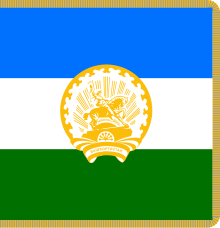Head of the Republic of Bashkortostan
| Head of the Republic of Bashkortostan |
|
|---|---|

Head's Seal
|
|
|
Government of the Republic of Bashkortostan Administration of Head of the Republic of Bashkortostan |
|
| Style |
Mr. President (in russian from 01.01.2015) |
| Member of | Government of the Republic of Bashkortostan |
| Residence | Republic House |
| Seat |
46 Tukaeva Street, |
| Term length | Five years renewable once |
| Constituting instrument | Bashkortostan Constitution |
| Formation | 24 December 1993 |
| First holder |
Murtaza Rakhimov 12 December 1993 |
| Website | President of Bashkortostan |
Mr. President
(before 01.01.2015)
(Bashkir: Башлығы)
(from 01.01.2015)
Head
46 Tukaeva Street,
Ufa,
450101
The Head of the Republic of Bashkortostan (before 1 January 2015 the title was called President;Bashkir: Башҡортостан Республикаһы Башлығы) is the highest executive position in the Republic of Bashkortostan, a federal subject of the Russian Federation.
The Head of Bashkortostan is appointed for a five-year term and must be a citizen of the Russian Federation who is at least thirty years old.
The first President of Bashkortostan was Murtaza Rakhimov, who has held the office from 12 December 1993. He was re-elected twice—on June 4, 1998 and on 21 December 2003. The election procedure was abolished in 2006, when Rakhimov was appointed President by the Bashkortostan Kurultai according to the recommendation of the President of Russia, Vladimir Putin.
Since 19 July 2010 the Head of the Republic of Bashkortostan is Rustem Khamitov.
The Head of the Republic of Bashkortostan is considered the head and CEO of the Republic; he heads the Government of the Republic Bashkortostan. The Head of the Republic of Bashkortostan represents the Republic of Bashkortostan in the relations with the President of the Russian Federation, the Federation Council and the State Duma of the Russian Federation’s Federal Assembly, other federal government bodies, government bodies of the Russian Federation’s subjects, governmental bodies of the Republic of Bashkortostan, local self-government bodies, public communities, other organizations and functionaries, including execution of international and external economic relations.
...
Wikipedia

